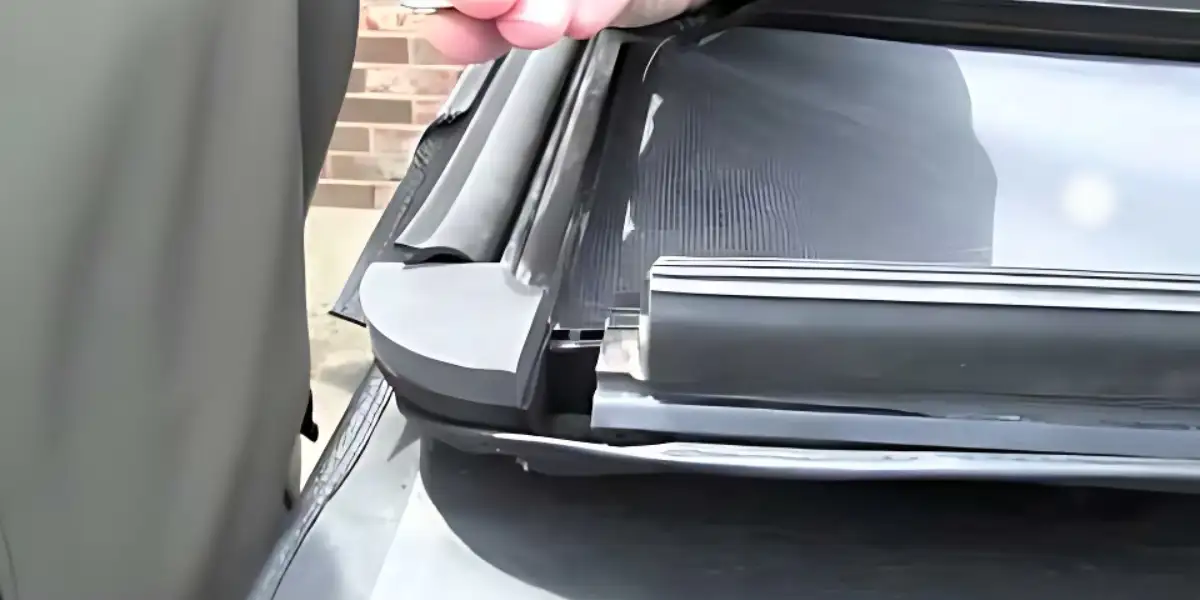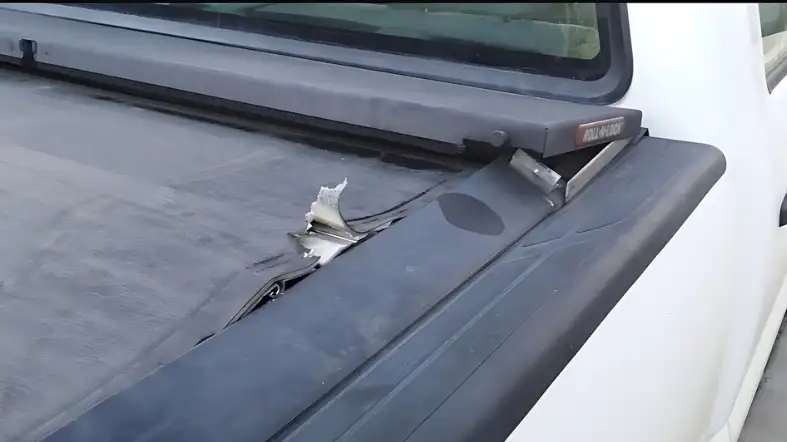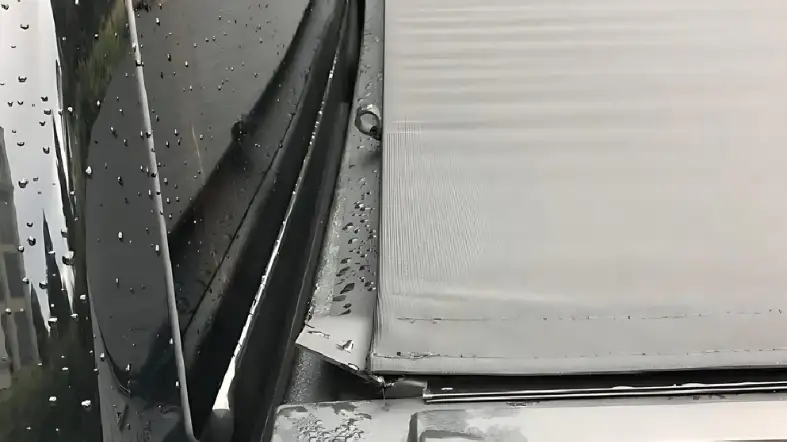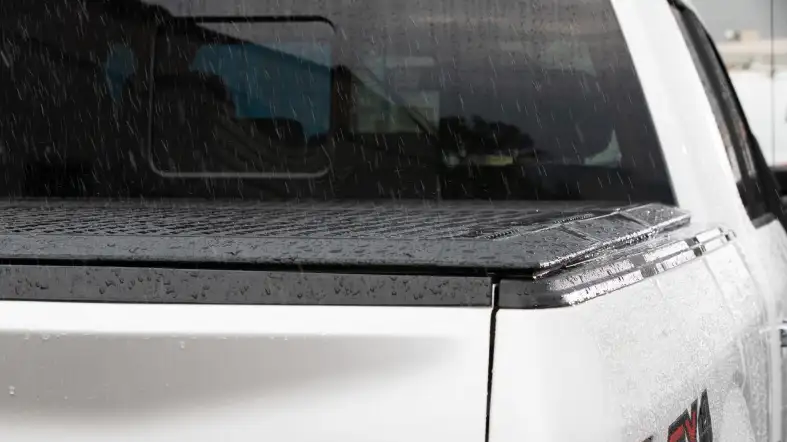Are you tired of dealing with a leaky tonneau cover? Don’t worry, we’ve got you covered!
Whether it’s due to worn-out seals, loose clamps, or even small tears in the cover material, fixing the leak is easier than you might think.
In this article, we’ll walk you through the step-by-step process of repairing a tonneau cover, helping you keep your truck bed dry and your cargo protected.
Say goodbye to unwanted water intrusion and get ready to restore the functionality of your tonneau cover. Let’s fix that leak once and for all!

How do you fix a leak in a tonneau cover?
Here’s a step-by-step guide to help you resolve the issue:
Clean and dry the tonneau cover
Begin by thoroughly cleaning the cover using a mild soap and water solution.
Make sure to remove any dirt or debris that could interfere with the repair process. After cleaning, allow the cover to completely dry before proceeding.
Locate the source of the leak
Carefully inspect the tonneau cover to identify the exact location of the leak. Look for signs of damage, such as tears, punctures, or worn-out seals.
This will help you determine the appropriate repair method.
Patch small holes or tears
If you have identified small holes or tears in the cover material, you can patch them using a tonneau cover repair kit.
These kits typically include adhesive patches that can be applied to the damaged area. Follow the manufacturer’s instructions to ensure proper application.
Replace damaged weather seals or gaskets
If the weather seals or gaskets are the cause of the leak, it may be necessary to replace them.
Remove the old seals or gaskets and install new ones according to the manufacturer’s guidelines. Ensure a tight and secure fit to prevent future leaks.
Tighten loose clamps and fasteners
Inspect all clamps and fasteners that secure the tonneau cover in place. If any are loose or damaged, tighten or replace them as needed.
Ensure that all components are securely fastened to create a watertight seal.
Apply a waterproof sealant
To further enhance the water resistance of your tonneau cover, consider applying a waterproof sealant.
This can be especially beneficial for covers with older or worn-out materials. Follow the instructions provided with the sealant to achieve the best results.
Test for leaks
After completing the repair process, it’s important to test the tonneau cover for any remaining leaks.
Use a hose or water source to simulate rain and check if water is still seeping through.
If leaks persist, re-evaluate the repair and make any necessary adjustments.

Identifying Common Causes of Tonneau Cover Leaks
To effectively fix the leak, it’s crucial to identify the root cause. Here are some common culprits:
Worn-out weather seals or gaskets
Over time, the weather seals or gaskets on your tonneau cover can deteriorate, creating gaps for water to infiltrate. Inspect these components for signs of wear or damage.
Loose or damaged clamps and fasteners
If the clamps and fasteners that secure the tonneau cover in place are not properly tightened, they can create spaces for water to enter. Check for any loose or damaged clamps and fasteners.
Tears or punctures in the cover material
The cover itself may have tears or punctures, which can lead to leaks.
Carefully examine the cover for any visible damage, paying close attention to the seams and edges.
Benefits of Fixing a Leaking Tonneau Cover
Here’s why it’s worth your time and effort to repair that leak:
Protect your cargo
A properly fixed tonneau cover keeps water out of your truck bed, safeguarding your cargo from damage caused by moisture.
Whether you’re transporting equipment, luggage, or other belongings, ensuring they stay dry is crucial for their longevity and condition.
Preserve the truck bed
Water intrusion can lead to rust and corrosion on your truck bed, potentially causing structural damage over time.
By fixing the leak, you prevent such issues and extend the lifespan of your truck bed, preserving its value and functionality.
Enhance security
A tonneau cover acts as a deterrent against theft, but a leak compromises its effectiveness.
By repairing the leak, you restore the cover’s ability to secure your belongings and provide an added layer of protection.
Improve fuel efficiency
A well-sealed tonneau cover reduces wind drag on your truck, resulting in improved aerodynamics.
This, in turn, can enhance fuel efficiency by reducing the workload on your engine and decreasing fuel consumption.
Enhance aesthetics
A leak-free tonneau cover not only performs better but also enhances the overall appearance of your truck. It gives your vehicle a sleek and finished look, adding to its visual appeal.
Increase the resale value
When it comes time to sell or trade in your truck, a tonneau cover in excellent condition adds value to the vehicle.
A repaired and well-maintained cover demonstrates that you have taken care of your truck, making it more attractive to potential buyers.
Factors Affecting the Effectiveness of Tonneau Cover Repairs

When it comes to repairing a tonneau cover, the effectiveness of the repair can vary depending on several factors.
Understanding these factors will help you make informed decisions and ensure a successful outcome. Here are key considerations to keep in mind:
Severity and extent of the damage
The severity and extent of the damage to your tonneau cover play a significant role in determining the effectiveness of the repair.
Minor tears or small gaps may be easily fixed with DIY methods, while extensive damage or large holes may require professional assistance or even replacement of the cover.
Age and condition of the cover material
The age and condition of the tonneau cover material can impact its ability to be effectively repaired.
Older covers with worn-out materials may not respond well to repairs and may require replacement for a long-lasting solution.
Quality of repair materials and techniques
The quality of the repair materials and techniques employed also affects the overall effectiveness of the repair.
Using high-quality adhesive patches, sealants, and replacement components, along with proper application techniques, can significantly enhance the repair’s durability and longevity.
Attention to detail during the repair process
The level of attention to detail during the repair process is crucial.
Taking the time to thoroughly clean and dry the cover, properly align and secure replacement parts, and ensure a tight seal will contribute to the effectiveness of the repair.
Ongoing maintenance and care
Even after successfully repairing a tonneau cover, ongoing maintenance, and care are essential to maintain its effectiveness.
Regularly inspecting the cover for signs of wear, promptly addressing any new damage or leaks, and following manufacturer-recommended maintenance practices will help maximize the longevity and performance of the repair.
Comparison: DIY Fixes vs. Professional Repairs for Tonneau Covers
When it comes to fixing a tonneau cover, you have two options: tackling the repair yourself or seeking professional assistance.
Each approach has its pros and cons. Let’s compare the two to help you make an informed decision.
DIY Fixes
Fixing the tonneau cover yourself can be a cost-effective solution, especially for minor repairs. Here are the advantages and considerations:
Affordability
DIY fixes typically involve purchasing repair kits or materials, which are often more budget-friendly compared to hiring a professional.
Convenience
DIY repairs allow you to address the issue at your convenience, without the need to schedule an appointment or wait for a service provider.
Learning experience
Taking on the repair yourself gives you the opportunity to learn new skills and gain a sense of accomplishment.
However, there are a few factors to consider with DIY fixes:
- Skill level required: Depending on the complexity of the repair, certain DIY fixes may require specific skills or tools. Assess your abilities and confidence before diving into the repair.
- Risk of mistakes: Without professional expertise, there is a risk of making mistakes during the repair process, potentially leading to ineffective repairs or further damage.
Professional Repairs
Seeking professional assistance offers expertise and ensures a high-quality repair. Consider the following advantages and factors:
Expertise and experience
Professionals have the knowledge and experience to accurately diagnose the issue and provide effective solutions. They are trained to handle a wide range of tonneau cover repairs.
Quality results
Professional repairs often come with warranties, giving you peace of mind knowing that the repair has been performed by skilled technicians.
Time-saving
Hiring professionals means you can save time and effort by leaving the repair in the hands of experienced individuals.
Keep in mind the following considerations when opting for professional repairs:
- Cost: Professional repairs can be more expensive compared to DIY fixes, as they often include labor costs and may involve replacement parts.
- Scheduling and availability: Depending on the availability of professionals in your area, scheduling the repair may require some flexibility.
Ultimately, the decision between DIY fixes and professional repairs depends on factors such as the complexity of the repair, your skill level, budget, and desired outcome.
Consider your abilities, time constraints, and the severity of the issue before making a choice.
Maintaining a Leak-Free Tonneau Cover: Tips and Tricks

Inspecting the Tonneau Cover Regularly
To ensure your tonneau cover remains leak-free, it is crucial to inspect it regularly. Begin by examining the cover for any visible signs of damage, such as tears, holes, or loose fittings.
Pay close attention to the seams, as they are often vulnerable areas where leaks can occur.
If you notice any damage, it is essential to address it promptly to prevent further issues.
By conducting routine inspections, you can identify and tackle potential problems before they worsen.
Cleaning the Tonneau Cover Properly
Keeping your tonneau cover clean is another vital aspect of maintaining its leak-free condition.
Begin by removing any debris, such as leaves or dirt, from the cover’s surface. You can use a soft brush or cloth to gently sweep away the loose particles.
Next, use a mild soap or specialized tonneau cover cleaner diluted with water to thoroughly clean the cover.
Avoid using harsh chemicals or abrasive materials that can damage the cover’s material or finish.
Rinse off the soap thoroughly and allow the cover to dry completely before closing it.
Cleaning the tonneau cover regularly not only enhances its appearance but also helps preserve its integrity.
Applying a Protective Sealant
Applying a protective sealant to your tonneau cover can provide an additional layer of defense against leaks.
There are various types of sealants available, including silicone-based products specifically designed for tonneau covers. Before applying the sealant, ensure the cover is clean and dry.
Follow the manufacturer’s instructions carefully to achieve optimal results. Applying the sealant to the seams and edges of the cover can help reinforce its waterproof properties and minimize the risk of leaks.
Regularly reapplying the sealant, as recommended by the manufacturer, will help maintain its effectiveness over time.
Adjusting and Tightening the Tonneau Cover
Over time, the tonneau cover may shift or become loose, leading to potential leaks.
To prevent this, regularly inspect the cover’s attachment points and adjust them if necessary.
Ensure that the cover is properly aligned with the bed of your truck or the mounting rails.
Check the tension of any tensioning mechanisms, such as straps or latches, and tighten them as needed.
By keeping the tonneau cover securely fastened, you can minimize the chances of water seeping through gaps or openings.
FAQs
Can I Repair A Leak In My Tonneau Cover Myself?
Yes, you can repair a leak in your tonneau and cover yourself in many cases.
It depends on the extent of the damage and the type of cover you have.
How Can I Temporarily Fix A Small Leak In My Tonneau Cover?
For a temporary fix, you can use waterproof tape or sealant to cover small holes or tears in the cover.
However, it’s important to note that this may not be a permanent solution.
What If The Seals On My Tonneau Cover Are Damaged?
If the seals on your tonneau cover are damaged, you can often purchase replacement seals from the manufacturer or a reputable dealer.
Follow the instructions provided to remove the old seals and install the new ones.
Is It Possible To Patch A Tear In A Tonneau Cover?
Yes, it is possible to patch a tear in a tonneau cover. You can use repair patches specifically designed for tonneau covers, which are usually adhesive and waterproof.
Clean the area around the tear, apply the patch, and ensure it is securely attached.
How Do I Realign My Tonneau Cover To Prevent Leaks?
To realign your tonneau cover, check the mounting points and ensure they are properly aligned with the bed of your truck or the mounting rails.
Adjust the tensioning mechanisms, such as straps or latches, to ensure a tight and secure fit.
When Should I Consider Replacing My Tonneau Cover Instead Of Repairing It?
If your tonneau cover has extensive damage, such as large tears, severe material degradation, or multiple leak points, it may be more cost-effective and practical to replace it rather than attempt repairs.
Consult with a professional or manufacturer for guidance on whether repair or replacement is the best option.
Final Words
Don’t let a pesky leak dampen your tonneau cover experience. With simple DIY steps, you can tackle the issue head-on.
Inspect for damage, clean regularly, apply a protective sealant, and adjust the cover for a snug fit.
Patch small tears or replace damaged seals. Remember, proactive maintenance and timely repairs ensure your tonneau cover stays leak-free, keeping your cargo dry and secure.
